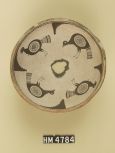Burials
 Mimbres burials remain distinctive from surrounding Southwest cultures (such as the Anasazi) through their custom of burying the dead beneath the floors of still occupied houses. Such burials were most typical of the rectangular pithouses dating from about A.D. 900. Remains would be placed in individual unlined pits that were situated adjacent to the foundation of the structure, with at least part of the body underneath a room in use. As with many, though not all, ancient cultures of the Southwest, the Mimbres included grave offerings and personal belongings in the burials of their dead. In addition to pottery, items such as tools, exotic stones, turquoise or shell jewelry, and even food were buried with the dead.
Mimbres burials remain distinctive from surrounding Southwest cultures (such as the Anasazi) through their custom of burying the dead beneath the floors of still occupied houses. Such burials were most typical of the rectangular pithouses dating from about A.D. 900. Remains would be placed in individual unlined pits that were situated adjacent to the foundation of the structure, with at least part of the body underneath a room in use. As with many, though not all, ancient cultures of the Southwest, the Mimbres included grave offerings and personal belongings in the burials of their dead. In addition to pottery, items such as tools, exotic stones, turquoise or shell jewelry, and even food were buried with the dead.
Pottery clearly played an important role in burials. In early burials bowls were placed with the other offerings next to the body. Later however, bowls were purposely broken and scattered around the grave. This practice gave way to yet another, as the Mimbres no longer broke the bowl into pieces, but made a single hole in the bottom of the piece and placed the bowl on the head of the body (image at ancestral.com site). The custom of breaking a single hole in the bowl is known today as “killing” the bowl, and the hole itself is called the “kill” hole (HM 97, 4784, 5103). “Killing” the bowl is thought to have released of the bowl’s spirit, and subsequently that of the deceased.
